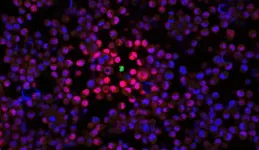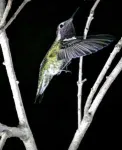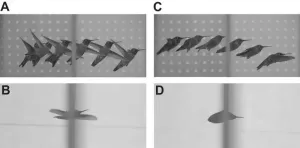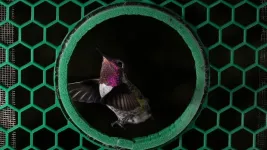(Press-News.org) The immune system is a crucial part of our survival, regularly fending off wide-ranging attacks on the body, both internal and external. Unsurprisingly, the elegant defense system that protects us from viruses, bacterial infections, cancer, and other threats is immensely complicated. Each time it mounts a response, it must quickly and carefully orchestrate communication across vast numbers of cells and molecules.
Jennifer Oyler-Yaniv is working to figure out how, exactly, the immune system does this — and when and why it fails.
“There's always the next question, the next thing we don’t understand. As a scientist, I have full creative freedom to get obsessed with problems,” said Oyler-Yaniv, who is an assistant professor of systems biology in the Blavatnik Institute at HMS.
In an ironic twist, Oyler-Yaniv launched her lab at HMS — which she co-leads with her partner, Alon Oyler-Yaniv — at the height of the COVID-19 pandemic, when immunology was garnering new levels of attention from scientists and the public alike.
Straddling the worlds of immunology and systems biology, the Oyler-Yaniv lab is using cancer as a model system to uncover the basic principles of how cells in the immune system communicate. In a conversation with Harvard Medicine News, Oyler-Yaniv discussed her interest in immunology, her approach to research, and her insights about the immune system and cancer.
HMNews: How would you describe the essence of your work?
Oyler-Yaniv: We’re an immunology lab that asks quantitative questions about the immune system. Broadly, we’re interested in how signaling molecules travel through tissues in the body, and how their behavior changes once they get to the target cells they’re going to act on. Specifically, we study cytokines, which are signaling molecules that enable cells in the immune system to communicate with each other. Cytokines are essential for the immune system to clear pathogens and kill tumors, but they can cause damage to the body when they act on cells not involved in the immune response. Because of that, their spatial dynamics must be very tightly regulated.
Our lab has two big wings. One wing is focused on understanding the biophysical principles that regulate the spread of cytokines through three-dimensional, dense tissues. We want to understand how these cytokines are spatially distributed in tissues, and what factors affect their distribution. We are interested in this topic from a basic immunology perspective, and for its clinical applications to cancer. On the other side, we’re interested in how cytokines change their decision-making when they act on cells, including decisions such as whether to die, proliferate, or become dormant. These decisions have important implications for viral infections and cancer.
HMNews: What sparked your interest in immunology?
Oyler-Yaniv: My interest in immunology took off during grad school. Immunotherapy was becoming a viable treatment option for people with cancer, and I was at Memorial Sloan Cancer Center, where a lot of the pioneering work was being done. We would see these survival curves where people who were very sick with cancer and expected to die enrolled in a clinical trial and ended up responding to immunotherapy. It was an incredibly energizing and exciting time to see what the immune system could do to treat cancer, and being in that environment provided me with a huge momentum to study the immune system. I’m interested in the immune system beyond cancer immunotherapy, but that was the catalyst for what got me so excited about it in the first place.
HMNews: You are an immunologist. Why did you join a systems biology department?
Oyler-Yaniv: As a field, systems biology aspires to extract details to find general principles and repeating patterns. That’s something I’m very interested in. My lab aims to identify broader patterns in the way groups of tissues or molecules behave to understand general principles of the immune system. For example, some of our research focuses on how the cytokine interleukin-2 interacts with immune cells called T cells. We are, of course, interested in the biology of that specific interaction, but we also think that it can be a model system to understand how cells communicate more generally. Ultimately, we hope that finding these general principles that can be applied broadly to different diseases and tissues will allow us to form a more unified view of the immune system.
Being in a systems biology department is helpful because we have the perspective of people who care about finding general principles and we are also able to do a lot of mathematical modeling. We use computational tools like machine learning to analyze very large imaging data sets, including data sets from human tumor specimens. A strength of our lab is analyzing those data sets to understand the spatial relationships between different cell types. We also do a lot of live cell microscopy and experiments with basic mouse models of disease, just like every other immunology lab. I think we are in a hybrid space between systems biology and immunology.
HMNews: Your lab recently published a paper on cytokines in melanoma. What were the central findings?
Oyler-Yaniv: I’ve been interested in the pro-inflammatory cytokine interferon-gamma for a long time. Interferon-gamma is an important cytokine in cancer because it is absolutely essential for certain cancer immunotherapies to work. Yet there have been really conflicting studies in mice and humans about the spatial spread of this cytokine through dense tissues — specifically, how far it can spread through a tumor. Some studies claim that this cytokine is released only to its nearest neighbor, and others claim that it can spread over long distances. We approached this question of spatial spread from a biophysics perspective: We generated dense, three-dimensional tissues in a lab dish that allowed us to have a lot of control over the experimental parameters as we investigated how far this cytokine can travel.
In a previous study, working with interleukin-2 as a model system, we found that the spread of molecules through dense tissue is a competition between diffusion, which spreads them further, and consumption, or uptake of molecules by cells with receptors that bind to them. In the new study, we found this is also true for interferon-gamma in the context of melanoma: We could predict how far interferon-gamma would spread in a tumor based on the amount and distribution of cells producing the cytokine and cells with receptors that bind to it. One of our key conclusions was that the only way you get widespread penetration of interferon-gamma through a tumor is if you have a lot of cells producing it and those cells are evenly distributed throughout the tissue. We think that this information could help refine biomarkers to identify who is likely to respond to immunotherapy. We are interested in applying this framework to understanding drug penetration with the idea that drugs are not too different from cytokines in how they spread through a tumor.
HMNews: When you aren’t in the lab, what else do you spend time on at HMS?
Oyler-Yaniv: I teach a science communication and ideation course to our first-year graduate students, which is one of two required courses. I care a lot about helping students communicate more effectively and helping them acquire confidence in coming up with new ideas. There are a lot of misconceptions in science that an idea just pops into someone’s head, when it’s really a lot of storytelling and putting pieces of data together. Research is a team effort, and coming up with ideas is hard. I think that we can normalize that for students and also help them develop a positive attitude and a mindset that it will get easier with time. This is especially important for students who might not have any scientists in their family, so might not be aware of these misconceptions about how creativity works in science. We can also give students some techniques to actually do it — to learn how to come up with ideas, and how to be original and innovative. These are things that are studied and taught in creative fields, but not really in science, so we want to do that.
Authorship, funding, disclosures
Additional authors on the PNAS paper include Edoardo Centofanti, Chad Wang, Sandhya Iyer, Oleg Krichevsky, and Alon Oyler-Yaniv.
This interview was edited for length and clarity
END
What human diseases can teach us about the immune system
Jennifer Oyler-Yaniv is using cancer as a model system to understand general principles of the immune system
2023-11-10
ELSE PRESS RELEASES FROM THIS DATE:
Texas A&M researchers contribute to international project studying coronavirus transmission in humans, cattle
2023-11-10
Researchers from the Texas A&M School of Veterinary Medicine and Biomedical Sciences’ (VMBS) Veterinary Education, Research, and Outreach (VERO) program have joined an international team studying how coronaviruses are spread and whether an individual’s microbiome (the collection of microbes living in or on the body) might impact that transmission.
Coronaviruses are a family of viruses that can cause a variety of diseases in many species, from the common cold and severe acute respiratory syndrome (SARS) in people, to diarrhea in calves and respiratory disease in ...
NASA’s Webb, Hubble telescopes combine to create most colorful view of universe
2023-11-10
Astronomers once again have combined the observational powers of NASA’s James Webb Space Telescope and Hubble Space Telescope to create one of the most detailed and colorful portraits of the cosmos, just in time for the holiday season.
The new image, dubbed the Christmas Tree Galaxy Cluster by the research team that includes Texas A&M University astronomer Dr. Lifan Wang, combines visible light from Hubble with infrared light detected by Webb to showcase MACS0416, a galaxy cluster about 4.3 billion light-years from Earth. Because the cluster is able to magnify the light from more distant background galaxies through a phenomenon known as gravitational ...
Ten 2023 postdoctoral fellowships in aging research awarded by the Glenn Foundation for Medical Research and AFAR
2023-11-10
NEW YORK, NY and SANTA BARBARA, CA — The American Federation for Aging Research (AFAR) and the Glenn Foundation for Medical Research are pleased to announce the recipients of the 2023 Glenn Foundation for Medical Research Postdoctoral Fellowships in Aging Research. This program supports postdoctoral fellowswho study basic research mechanisms of aging and/or translational findings that have potential to directly benefit human health.
Selected through a rigorous review process, ten, one-year, $75,000 Postdoctoral ...
Mystery solved: how hummingbirds fly through gaps that are too small
2023-11-10
Soaring, wings outstretched, many birds sail through the air unhindered. However, species that dine on fruit, seeds and nectar must negotiate tiny gaps in cluttered foliage to secure a feast. To pass through apertures, many birds pull in their wings, folding them closer to their bodies. However, some of the most manoeuvrable aviators, hummingbirds, have lost the ability to fold their wings at the wrists and elbows. ‘Unless hummingbirds implement distinctive strategies to transit narrow apertures, they may be unable to enter gaps less than one wingspan wide’, ...
Hummingbirds' unique sideways flutter gets them through small apertures
2023-11-10
Most birds that flit through dense, leafy forests have a strategy for maneuvering through tight windows in the vegetation — they bend their wings at the wrist or elbow and barrel through.
But hummingbirds can't bend their wing bones during flight, so how do they transit the gaps between leaves and tangled branches?
A study published today in the Journal of Experimental Biology shows that hummingbirds have evolved their own unique strategies — two of them, in fact. These strategies have not been reported before, likely because hummers maneuver too ...
National analysis suggests that potentially serious complications occur in 1 in 18 procedures under the care of an anaesthetist
2023-11-10
New survey data from the 7th National Audit Project of the Royal College of Anaesthetists (NAP7) published in Anaesthesia (the journal of the Association of Anaesthetists) shows that potentially serious complications occur in one in 18 procedures under the care of an anaesthetist.
The risk factors associated with these potentially serious complications include very young age (babies); comorbidities; being male; increased frailty; the urgency and extent of surgery; and surgery taking place at night and/or at weekends.
This paper has been produced by a team of authors across ...
Study finds that laser epilation reduces risk of recurrence of pilonidal disease
2023-11-09
Laser epilation, commonly known as laser hair removal, reduced the risk of recurrence in patients with pilonidal disease, an inflammatory, painful, and sometimes chronic or recurring condition, according to research conducted by Peter C. Minneci, M.D., Chair of Surgery at Nemours Children’s Health, Delaware Valley, and published in JAMA Surgery.
Pilonidal disease occurs when cysts form between the buttocks. It is believed to be an inflammatory reaction to hair or debris that gets caught in the crease of the buttocks. The disease occurs in 26 to 100 per 100,000 people and is most common in adolescents and young ...
The U.S. Supreme Court restricted abortion rights and public support for abortion increased
2023-11-09
A new study examining the effects of the U.S. Supreme Court ruling on Dobbs v. Jackson Women's Health Organization on June 24, 2022, which overturned Roe v. Wade's constitutional protection of abortion rights, finds that the American public's support for abortion increased after the decision.
The findings were published today in Nature Behaviour.
"Our results show the extent to which the Supreme Court is out of step with the American public," says co-author Sean Westwood, an associate professor of government at Dartmouth and director of the Polarization Research Lab.
The study's findings were based on a large, three-wave survey before the leak ...
New evidence that heightened pain sensitivity is linked to sympathy for opposing political views
2023-11-09
The next time your friend displays remarkable openness to their opposite political camp’s ideas, you might try pinching them.
Okay, we don’t really recommend that. But new evidence shows that people with increased sensitivity to pain are also more likely to endorse values more common to people of their opposite political persuasion. It doesn’t stop there. They also show stronger support for the other camp’s politicians, and, get this -- more likely to vote for Donald Trump in 2020 if they are liberal, or Joe Biden if they are conservative.
Even ...
C-Path’s pioneering neuroscience workshop transforms the landscape of neurological disorder therapies
2023-11-09
Critical Path Institute (C-Path) is pleased to announce the release of a new peer-reviewed publication, titled “Transforming Drug Development for Neurological Disorders: Proceedings from a Multi-disease Area Workshop,” now published in Neurotherapeutics, The Journal of the American Society for Experimental Neurotherapeutics.
A distinguished team of C-Path scientists and patient-advocates spearheaded by Diane Stephenson, Ph.D., C-Path’s Executive Director of the Critical Path for Parkinson’s Consortium (CPP), has presented its learnings from C-Path’s 2022 Neuroscience Program Annual Workshop. The publication can be accessed in its entirety here.
Neurological ...
LAST 30 PRESS RELEASES:
Singapore scientists discover lung cancer's "bodyguard system" - and how to disarm it
Bacteria use wrapping flagella to tunnel through microscopic passages
New critique prompts correction of high-profile Yellowstone aspen study, highlighting challenges in measuring ecosystem response to wolf reintroduction
Stroke survivors miss critical treatment, face greater disability due to systemic transfer delays
Delayed stroke care linked to increased disability risk
Long term use of anti-acid drugs may not increase stomach cancer risk
Non-monetary 'honor-based' incentives linked to increased blood donations
Natural ovulation as effective as hormones before IVF embryo transfer
Major clinical trial provides definitive evidence of impacts of steroid treatment on severe brain infection
Low vitamin D levels shown to raise risk of hospitalization with potentially fatal respiratory tract infections by 33%
Diagnoses of major conditions failing to recover since the pandemic
Scientists solve 66 million-year-old mystery of how Earth’s greenhouse age ended
Red light therapy shows promise for protecting football players’ brains
Trees — not grass and other greenery — associated with lower heart disease risk in cities
Chemical Insights scientist receives Achievement Award from the Society of Toxicology
Breakthrough organic crystalline material repairs itself in extreme cold temperatures, unlocking new possibilities for space and deep-sea technologies
Scientists discover novel immune ‘traffic controller’ hijacked by virus
When tropical oceans were oxygen oases
Positive interactions dominate among marine microbes, six-year study reveals
Safeguarding the Winter Olympics-Paralympics against climate change
Most would recommend RSV immunizations for older and pregnant people
Donated blood has a shelf life. A new test tracks how it's aging
Stroke during pregnancy, postpartum associated with more illness, job status later
American Meteorological Society announces new executive director
People with “binge-watching addiction” are more likely to be lonely
Wild potato follows a path to domestication in the American Southwest
General climate advocacy ad campaign received more public engagement compared to more-tailored ad campaign promoting sustainable fashion
Medical LLMs may show real-world potential in identifying individuals with major depressive disorder using WhatsApp voice note recordings
Early translational study supports the role of high-dose inhaled nitric oxide as a potential antimicrobial therapy
AI can predict preemies’ path, Stanford Medicine-led study shows
[Press-News.org] What human diseases can teach us about the immune systemJennifer Oyler-Yaniv is using cancer as a model system to understand general principles of the immune system





